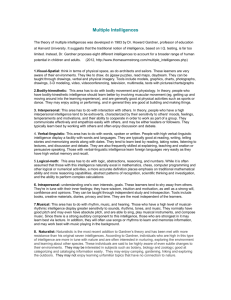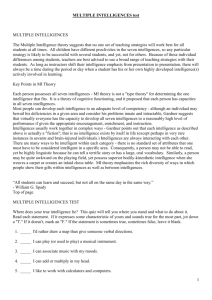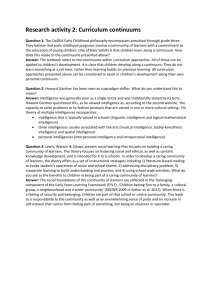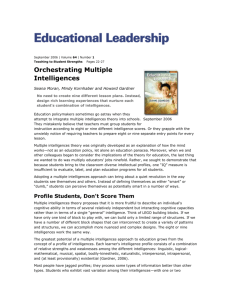Summary Article about Multiple Intelligences
advertisement
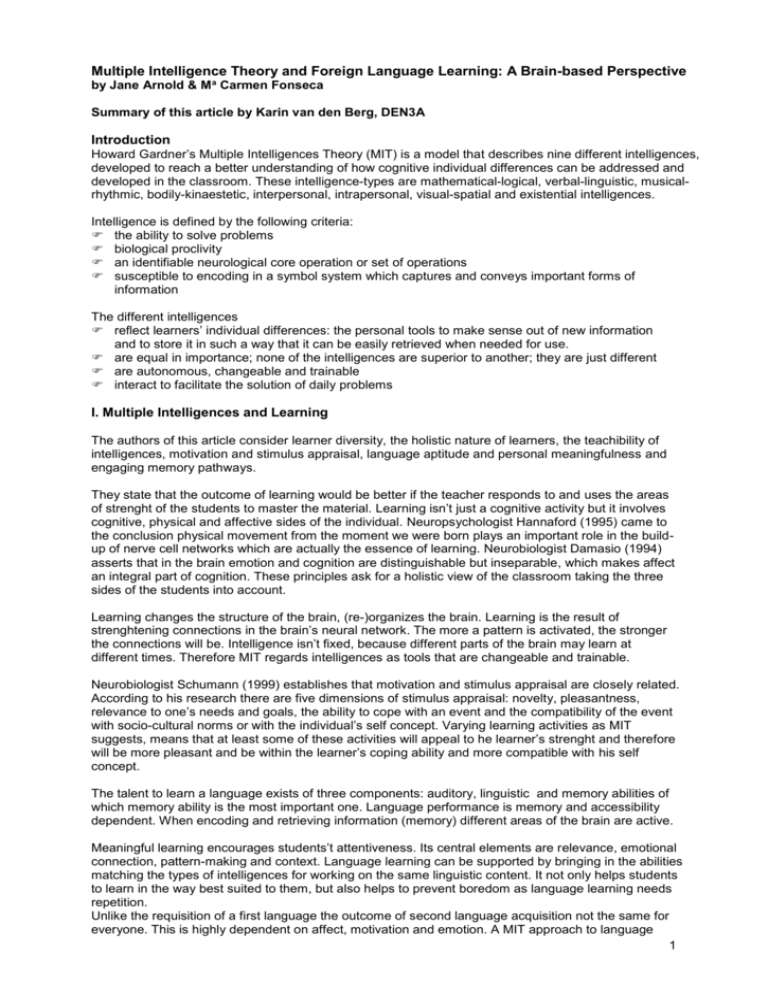
Multiple Intelligence Theory and Foreign Language Learning: A Brain-based Perspective by Jane Arnold & M a Carmen Fonseca Summary of this article by Karin van den Berg, DEN3A Introduction Howard Gardner’s Multiple Intelligences Theory (MIT) is a model that describes nine different intelligences, developed to reach a better understanding of how cognitive individual differences can be addressed and developed in the classroom. These intelligence-types are mathematical-logical, verbal-linguistic, musicalrhythmic, bodily-kinaestetic, interpersonal, intrapersonal, visual-spatial and existential intelligences. Intelligence is defined by the following criteria: the ability to solve problems biological proclivity an identifiable neurological core operation or set of operations susceptible to encoding in a symbol system which captures and conveys important forms of information The different intelligences reflect learners’ individual differences: the personal tools to make sense out of new information and to store it in such a way that it can be easily retrieved when needed for use. are equal in importance; none of the intelligences are superior to another; they are just different are autonomous, changeable and trainable interact to facilitate the solution of daily problems I. Multiple Intelligences and Learning The authors of this article consider learner diversity, the holistic nature of learners, the teachibility of intelligences, motivation and stimulus appraisal, language aptitude and personal meaningfulness and engaging memory pathways. They state that the outcome of learning would be better if the teacher responds to and uses the areas of strenght of the students to master the material. Learning isn’t just a cognitive activity but it involves cognitive, physical and affective sides of the individual. Neuropsychologist Hannaford (1995) came to the conclusion physical movement from the moment we were born plays an important role in the buildup of nerve cell networks which are actually the essence of learning. Neurobiologist Damasio (1994) asserts that in the brain emotion and cognition are distinguishable but inseparable, which makes affect an integral part of cognition. These principles ask for a holistic view of the classroom taking the three sides of the students into account. Learning changes the structure of the brain, (re-)organizes the brain. Learning is the result of strenghtening connections in the brain’s neural network. The more a pattern is activated, the stronger the connections will be. Intelligence isn’t fixed, because different parts of the brain may learn at different times. Therefore MIT regards intelligences as tools that are changeable and trainable. Neurobiologist Schumann (1999) establishes that motivation and stimulus appraisal are closely related. According to his research there are five dimensions of stimulus appraisal: novelty, pleasantness, relevance to one’s needs and goals, the ability to cope with an event and the compatibility of the event with socio-cultural norms or with the individual’s self concept. Varying learning activities as MIT suggests, means that at least some of these activities will appeal to he learner’s strenght and therefore will be more pleasant and be within the learner’s coping ability and more compatible with his self concept. The talent to learn a language exists of three components: auditory, linguistic and memory abilities of which memory ability is the most important one. Language performance is memory and accessibility dependent. When encoding and retrieving information (memory) different areas of the brain are active. Meaningful learning encourages students’t attentiveness. Its central elements are relevance, emotional connection, pattern-making and context. Language learning can be supported by bringing in the abilities matching the types of intelligences for working on the same linguistic content. It not only helps students to learn in the way best suited to them, but also helps to prevent boredom as language learning needs repetition. Unlike the requisition of a first language the outcome of second language acquisition not the same for everyone. This is highly dependent on affect, motivation and emotion. A MIT approach to language 1 teaching might help to develop the students’ verbal linguistic intelligence by calling upon the different talents/intelligences of the students. (sustained deep learning) II. Frames For Language Teaching 1. Musical-Rhythmic Intelligence = the ability to perceive and appreciate rhythm, pitch and melody. Listening to music (in- and outside the classroom) has a positive effect on the development of learners’ spatial-temporal intelligence. It also helps to concentrate and to stimulate creative processes. 2. Visual-Spatial Intelligence = the ability we have to perceive all the elements (form,shape,line, space, colour) necessary to create a mental image of something. Mental images are present in thought, have a strong influence on reasoning and are important for providing comprehensible and meaningful input for second language learners. Our imagery system gives us information about the non-linguistic world. The more connections between imagery and words in the target language, the better. Images connected to words facilitate information retrieval. 3. Logical-Mathematical Intelligence = the ability to use numbers effectively and to understand the underlying principles of a causal system. In the classrooom this means teaching reasoning strategies. 4. Bodily-Kinaesthetic Intelligence = the ability to use the body to express oneself, to handle physical objects skilful. This is not only important for the body but also for the use of the mind. To call upon this intelligence teachers can apply activities such as role-play, drama, games, project work in the classroom as well as activities concerning non-verbal communication (culturally determined gestures). 5. The Interpersonal Intelligence = the ability to understand other people, to work cooperatively and to communicate effectively. This ability is strongly connected to learning a second language as language learning is a social process, because development of communicative competence is one of its main goals. Cooperative learning (students in small groups interact and cooperate to carry out different tasks) supports this ability. “Active listening” strategies can help to develop empathy, which can help to create a more relaxed classroom atmosphere with speakers more self-confident and willing to speak in the target language. 6. The Intrapersonal Intelligence = the ability to understand the internal aspects of the self and to practise self-discipline. Knowing your learning style can help a student to optimize his performance. Self-discipline is based upon the perception of personal emotions, the ability to control them and the talent voor intrinsic motivation. An example of a task for this ability is a reading activity where students develop their attitudes towards a problem. 7. Natural Intelligence = the ability to discriminate among numerous species of flora and fauna, enjoyment of the natural world and ecological sensitivity. Activities such as brainstorming on recycling paper or tasks involving direct field observation can be done and semantic maps relation to nature can be used to develop the lexical knowledge. Conclusion A variety of language activities stimulating the different intelligences can assist in producing sustained deep learning,. The teachers can reach this more effectively by providing a balanced approach of various activities based upon MI. Pupils’ beliefs about their ability to be successful in a language assignment can be influenced by the way the teachers present the material and by teachers focussing on what students can do (instead of can’t do). This will have a positive effect on their self-esteem and can lead to enhancing success in language learning. Society requires people who have developed multilingual skills, who are capable of setting and achieving personal goals, who know how to find information needed for learning beyond the classroom, and people who can cooperate. Using MIT can help to achieve these goals. 2

